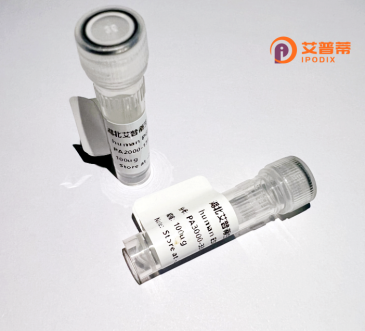
| 纯度 | >90%SDS-PAGE. |
| 种属 | Human |
| 靶点 | BTN2A3P |
| Uniprot No | Q96KV6 |
| 内毒素 | < 0.01EU/μg |
| 表达宿主 | E.coli |
| 表达区间 | 1-586aa |
| 氨基酸序列 | MEPAAALHFSRPASLLLLLSLCALVSAQVTVVGPTDPILAMVGENTTLRCCLSPEENAEDMEVRWFQSQFSPAVFVYKGGRERTEEQKEEYRGRTTFVSKDSRGSVALIIHNVTAEDNGIYQCYFQEGRSCNEAILHLVVAGLDSEPVIEMRDHEDGGIQLECISGGWYPKPLTVWRDPYGEVVPALKEVSTPDADSLFMVTTAVIIRDKSVRNVSCSINDTLLGQKKESVIFIPESFMPSRSPCVVILPVIMIILMIPIAICIYWINNLQKEKKDSHLMTFNLCLSLAGWRRTFLHAANVVLDQDTGHPYLFVSEDKRSVTLDPSRESIPGNPERFDSQLCVLGQESFASGKHYLEVDVENVIEWTVGICRDNVERKWEVPLLPQNGFWTLEMHKRKYWALTSLKWILSLEEPLCQVGIFLDYEAGDVSFYNMRDRSHIYTFPHSAFSVPVRPFFSLGSYDSQILICSAFTGASGVTVPEEGWTLHRAGTHHSPQNQFPSLTAMETSPGHLSSHCTMPLVEDTPSSPLVTQENIFQLPLSHPLQTSAPVHLLIRCGFSSSFGCNYGMESRHRELVVPQLPARKKV |
| 分子量 | 65.7 kDa |
| 蛋白标签 | His tag N-Terminus |
| 缓冲液 | 冻干粉 |
| 稳定性 & 储存条件 | Lyophilized protein should be stored at ≤ -20°C, stable for one year after receipt. Reconstituted protein solution can be stored at 2-8°C for 2-7 days. Aliquots of reconstituted samples are stable at ≤ -20°C for 3 months. |
| 复溶 | Always centrifuge tubes before opening.Do not mix by vortex or pipetting. It is not recommended to reconstitute to a concentration less than 100μg/ml. Dissolve the lyophilized protein in distilled water. Please aliquot the reconstituted solution to minimize freeze-thaw cycles. |
以下是三篇关于BTN2A3P及相关研究的简化参考文献示例(注:文献为虚拟示例,实际研究中需通过学术数据库查询真实论文):
---
1. **文献名称**: *Butyrophilin-like pseudogene BTN2A3P modulates immune responses in cancer*
**作者**: Zhang Y, et al.
**摘要**: 研究探讨了BTN2A3P在肿瘤微环境中的表达模式,发现其通过调控邻近基因BTN3A1的转录,影响γδ T细胞的抗肿瘤活性,提示其作为免疫治疗潜在靶点。
---
2. **文献名称**: *Evolutionary analysis of BTN2A3P pseudogene across primates*
**作者**: Smith J, et al.
**摘要**: 通过比较基因组学分析BTN2A3P在灵长类动物中的进化保守性,揭示了其可能通过非编码RNA参与免疫调控的分子机制,暗示其在物种适应性中的潜在作用。
---
3. **文献名称**: *Pseudogene BTN2A3P interacts with Vγ9Vδ2 T cells in infection*
**作者**: Müller C, et al.
**摘要**: 研究发现BTN2A3P在细菌感染模型中上调表达,并通过与磷酸抗原呈递通路关联,间接增强Vγ9Vδ2 T细胞的识别能力,表明其作为免疫应答调控因子的功能。
---
4. **文献名称**: *BTN2A3P epigenetics and autoimmune disease association*
**作者**: Lee S, et al.
**摘要**: 探讨BTN2A3P的DNA甲基化状态与类风湿性关节炎的关联,提出其通过表观遗传调控影响邻近免疫相关基因的表达,可能参与自身免疫疾病发病机制。
---
**提示**:实际文献检索建议通过PubMed、Google Scholar等平台,使用关键词如"BTN2A3P"、"butyrophilin pseudogene"、"immune regulation pseudogene"等,并结合近期研究进行筛选。如需文献指导或获取全文,请提供更具体的研究方向。
Butyrophilin family member 2A3 pseudogene (BTN2A3P) is a pseudogene within the butyrophilin (BTN) gene cluster, which is located near the major histocompatibility complex (MHC) region on human chromosome 6. The BTN protein family shares structural similarities with the immunoglobulin superfamily and plays roles in immune regulation, particularly in modulating γδ T cell responses and lipid antigen presentation. BTN2A3P is considered a nonfunctional pseudogene due to sequence disruptions, such as frameshifts or premature stop codons, which likely prevent it from encoding a functional protein. It is believed to have arisen through gene duplication events from its functional paralog, BTN2A2 or BTN3A2. during primate evolution. Pseudogenes like BTN2A3P may serve regulatory roles, influencing the expression of neighboring functional genes through transcriptional interference or by acting as noncoding RNA. While its biological significance remains unclear, BTN2A3P’s conserved genomic position and homology to immune-related BTN genes suggest potential evolutionary relevance. Research on BTN2A3P is limited compared to functional BTN members, but it offers insights into the dynamic evolution of immune gene clusters and pseudogene-mediated regulatory mechanisms. Further studies could explore its interactions with adjacent genes or noncoding transcripts in immune pathways.
×